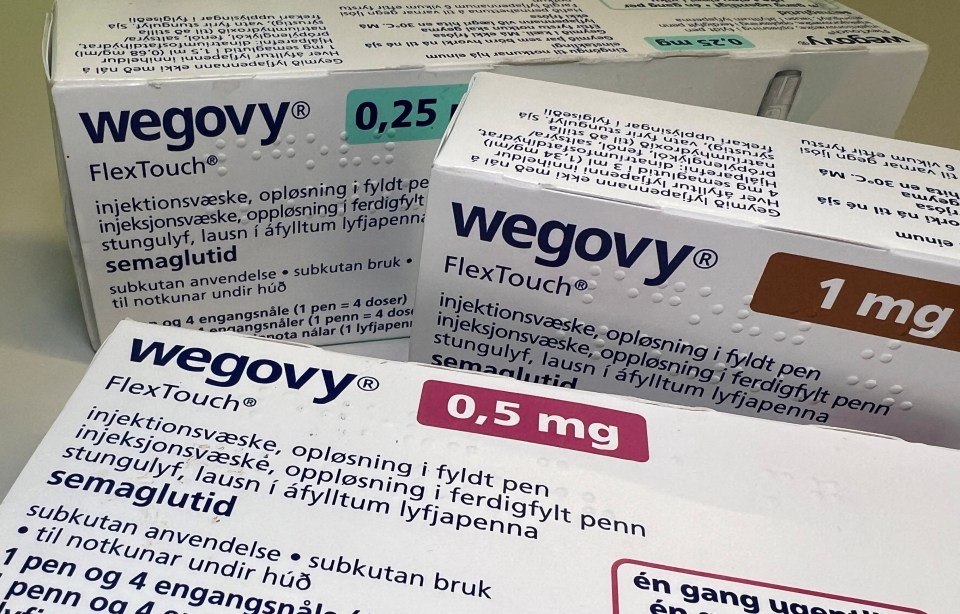New fat jab ‘golden dose’ is ‘safe and more effective’ – blasting nearly a FIFTH of body weight
A HIGHER ‘golden dose’ of Wegovy than is currently approved is safe and could be more effective – helping patients lose nearly a fifth of their body weight.
The once-weekly injection containing the semaglutide – also the active ingredient in diabetes jab Ozempic – is prescribed on the NHS at a maximum dose of 2.4mg.
Now, two major studies show that tripling doses to 7.2mg can trigger significant weight loss, without bringing on more side effects or risking patient safety.
The findings, published in The Lancet Diabetes & Endocrinology journal, suggest a higher dose of semaglutide could be an option for people with obesity – as well as type 2 diabetes – who haven’t lost enough weight on standard doses.
“Once-weekly subcutaneous semaglutide 2.4 mg is approved for weight management in people with obesity and related complications,” researchers said.
“However, some individuals do not reach their therapeutic goals with this dose.
“We aimed to test the efficacy and safety of a higher dose of semaglutide in people with obesity.”
Researchers investigated whether 7.2mg semaglutide injections could provide patients with “further benefits” and boost fat loss for people whose weight had plateaued “without jeopardising safety or significantly increasing the risk of adverse events”.
The two trials involved more than 2,000 adults with obesity, some of whom also had diabetes.
They were conducted across 95 hospitals, specialist clinics, and medical centres in 11 countries, including Canada, Germany, Greece, Norway and the US.
Researchers randomly assigned participants the 7.2mg dose, the 2.4mg dose, or placebo injections.
All participants received advice on improving diet and increasing exercise.
After 72 weeks, people without diabetes given the higher dose lost an average of 18.7 per cent of their body weight.
Those on the standard dose 15.6 per cent of their weight and those on placebo injections lost just 3.9 per cent.
Almost half of those on the higher dose lost at least 20 per cent of their body weight, while nearly a third shed 25 per cent or more.
This rivals the average weight lost with competitor jab Mounjaro, known as the ‘King Kong’ of weight loss injections.
Participants on the higher dose also saw their waists shrink and reported improvements in their blood pressure, blood sugar, and cholesterol levels – all key factors in reducing obesity-related health risks.
As for obese adults with type 2 diabetes, the 7.2mg dose caused them to lose 13 per cent of their weight.
Those on 2.4mg lost 10 per cent of their body weight on average, while placebo-users lost 4 per cent.
Both trials showed the higher semaglutide dose to be safe and generally well tolerated, though people taking 7.2mg did report more side effects.
WHO IS ELIGIBLE FOR WEIGHT LOSS JABS ON THE NHS?
NHS eligibility for weight loss injections has expanded but still lags behind the number who could potentially benefit from taking them.
Wegovy, medical name semaglutide, is only available for weight loss through specialist weight management clinics.
Patients are typically expected to have tried other weight loss methods before getting a prescription.
They may be eligible if their body mass index (BMI) is higher than 30, or higher than 27 if they have a weight-related health condition such as high blood pressure.
Mounjaro, known as tirzepatide, is also available from GP practices but currently only to patients with a BMI of 40 or higher (or 37.5 if from a minority ethnic background) plus four weight-related health conditions.
The medicines are currently being rationed to the patients most in need.
NHS watchdog NICE estimates that more than three million Brits will ultimately be eligible.
The GLP-1 injections are prescribed separately by GPs for people with type 2 diabetes, and patients should discuss this with their doctor.
“Serious adverse events” were reported by 68 of 1004 participants receiving the 7.2mg dose of semaglutide – about 7 per cent – researchers said.
Meanwhile, 22 of 201 taking 2.4mg reported side effects – about 11 per cent – and 11 of 201 receiving placebo injections, researchers said.
Nausea and diarrhoea, and some sensory symptoms like tingling, were the most common.
However, most side effects were manageable and resolved over time, researchers said.
One in 20 patients taking the higher dose stopped treatment because of side effects, similar to the standard jab.
Study authors concluded: “Semaglutide 7.2 mg was superior to placebo and semaglutide 2.4 mg in reducing bodyweight, including reaching reductions of 20 per cent or greater and 25 per cent or greater over 72 weeks.
The higher dose was “well tolerated and provided additional clinically meaningful weight loss compared with 2.4 mg, suggesting that higher doses could help patients who do not achieve sufficient weight loss with the currently approved dose”, they added.
But Professor Alex Miras, an obesity expert at Imperial College London, was more hesitant in touting the benefits of the 7.2mg dose.
He told the Daily Mail: “Tripling the dose only gives a marginal extra benefit, but the dose increase is massive.
“Going from 2.4mg to 7.2mg is a very big jump. I’m concerned many patients won’t tolerate such a high dose.
“In clinical practice people already struggle at 2.4mg.
“Even if 7.2mg is approved, I suspect uptake will be low because of cost and side-effects – the top dose is already expensive.”
It comes as many Brits taking weight loss jabs privately are priced out of paying for Mounjaro – after manufacturer Eli Lilly hiked up prices.
The highest dose was set to rise from £122 to £330 a month – an increase of 170 per cent – from September 1.
It was later reported that some pharmacies would be able to offer the jabs at a discount, saving patients £83 on the cost of the maximum dose.
But the price rise has still made Mounjaro unaffordable for many – leading Brits to switch to cheaper Wegovy or give up the jabs altogether.
In the UK, fewer than 200,000 people are thought to be accessing weight-loss jabs through the NHS, but over 1.4 million are estimated to be using them privately, according to the health think-tank the King’s Fund.
Meanwhile, jabs such as Ozempic, Wegovy and Mounjaro have been connected to 24 deaths in the 21 weeks since January, The Sun revealed.
The 7 fat jab mistakes stopping you losing weight
WHILE weight loss jabs have been hailed as a breakthrough in helping tackle Britain’s obesity crisis, some users say they’re missing out on their waist-shrinking powers – and it could be down to some simple mistakes…
POOR PENMANSHIP
Many people don’t correctly use the injection pen, according to Ana Carolina Goncalves, a pharmacist at Pharmica in Holborn, London.
Make sure to prime your weight loss pen correctly, as per the instructions. If nothing comes out, try again, and if it still doesn’t work, switch the needle or ask a pharmacist for help.
It’s also recommended to rotate injection sites between the abdomen, thigh and upper arm to avoid small lumps of fat under the skin.
TIME IS OF THE ESSENCE
Make sure you’re using the jabs on the most effective day of your schedule.
For example, taking the jab right before a takeaway or party won’t stop you from indulging, says Jason Murphy, head of pharmacy and weight loss expert at Chemist4U.
Weight loss injections need time to build up in your system, so if you’re planning for a heavier weekend, inject your dose mid-week.
MAKING A MEAL OF IT
You may not feel the urge to overeat at mealtimes due to the jabs. But skipping meals altogether can backfire, says Dr David Huang, director of clinical innovation at weight loss service Voy.
If a person is extremely malnourished, their body goes into emergency conservation mode, where their metabolism slows down.
FOOD FOR THOUGHT
A key mistake using weight loss jabs is not eating the right foods.
As well as cutting out sugary drinks and alcohol, Dr Vishal Aggarwal, Healthium Clinics recommends focusing on your protein intake.
DE-HYDRATION STATIONS
Dehydration is a common side effect of weight loss injections. But it’s important to say hydrated in order for your body to function properly.
Dr Crystal Wyllie, GP at Asda Online Doctor, says hydration supports metabolism, digestion, and can reduce side effects like headaches, nausea and constipation.
MOVE IT, MOVE IT
It can be easy to see the jabs as a quick fix, but stopping exercising altogether is a mistake, says Mital Thakrar, a pharmacist from Well Pharmacy.
Exercise helps maintain muscle mass and help shape the body as you lose weight, which may be crucial if you’re experiencing excess skin.
QUIT IT
While there’s the tendency to ditch the jabs as soon as you reach your desired weight, stopping them too soon can cause rapid regain.
Mr Thakrar recommends building habits like healthier eating during treatment for sustaining results.



